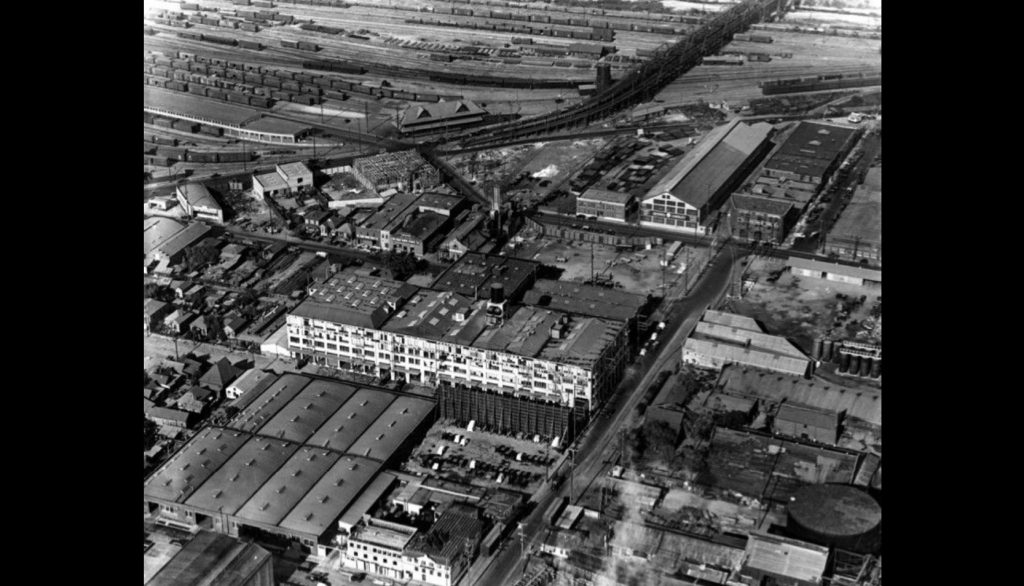- Home
- /
- History of Arts District DTLA
- /
- The Arts District – History in DTLA
The Arts District – History in DTLA
Posted By Barker Block HOA on April 17, 2023
The history of the Arts District is one of constant change –many endings and beginnings. With the neighborhood under an influx of new businesses, residents, and developments, it is a good time to reflect on the neighborhood’s history and to think about how the historic architecture can continue to play an important role in its unique identity.
From Grapevines to Railroads
Had you visited the area now known as the Arts District in the mid nineteenth century, you would have seen acres of vineyards. In fact, Vignes Street, which runs through the northern edge of the district, was named after “the father of French immigration to Los Angeles,” Jean-Louis Vignes. He arrived from France in 1831 and found in Southern California the perfect climate for planting grapes. In 1833 he planted grapes from France, and by 1847, Vignes’ vineyard, El Aliso, was the largest producer of wine in California. Other winemakers and fruit growers followed Vignes, and by the late nineteenth century, oranges and grapefruit had outpaced grapes as the primary product of the area.
Railroads and manufacturing emerged to serve the citrus industry’s shipping needs, and later to support the large number of people moving into California, and so began the transportation and industrial chapter in this neighborhood’s history.

Photo courtesy of Los Angeles Public Library Photo Collection.
Industrial Boom
Despite the residential enclaves, this neighborhood was on a clear path toward industrialization during the early twentieth century. The city’s population explosion contributed to the expansion of the regional economy. By the 1920s, Los Angeles had become the fifth-largest city in the United States and the seventh-wealthiest in the nation.
Key manufacturers located in the Arts District at this time were producing bakery products, women’s clothing, foundry and machinery goods, furniture, printing and publishing materials, automobile parts, and rubber.
By the end of World War II, this neighborhood was clearly industrial in nature, but it began to face challenges as industrial needs evolved. As railroads gave way to the trucking industry, large trucks had difficulty accessing some of the smaller streets that were once railroad spurs. Manufacturing plants grew larger in size, yet land parcels in the neighborhood were small.
As companies moved away to build larger, more modern factories, the warehouses of the Arts District stood vacant and the neighborhood began to decay.
Enter the Artists
In the 1970s, a group of artists, many of whom were being priced out of the increasingly expensive Venice and
Hollywood art scenes, saw opportunity in the forgotten buildings in the Arts District. Vacant warehouses made for
massive live/work studios at rock bottom prices. Yet moving into an abandoned industrial neighborhood was not easy for these pioneering artists, who had to hide during building inspections by the fire department and live in inhospitable surroundings.
One of the most important legacies from these early artist/ developers is that by rehabilitating the vacant warehouses, they saved an important part of L.A.’s industrial and transportation past. They became grassroots preservationists.
In 1999, the City of Los Angeles passed its landmark Adaptive Reuse Ordinance (ARO), which relaxed zoning codes for the conversion of pre-1974 commercial and industrial buildings into residential uses for non-artists. The ARO spurred another significant wave of development in the Arts District and shone a spotlight on the neighborhood as a creative and unique place to live.
Today, the Arts District remains the home of many artists as well as those in other creative industries, including green technology, architecture, and entertainment, while still retaining some of its industrial use.
Over nearly two centuries, the Arts District has evolved from vineyards, to working-class neighborhoods, to bustling industry, to abandoned factories, to artists’ mecca, to urban oasis.
